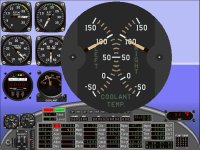Hello Aleatorylamp,
If you have three engine gauges, that probably means they are FS98 type.
Perhaps with three working examples, you can use a hex editor to create a fourth gauge?
This issue with finding one or two of a set and needing the other gauges is why I am spending the time to program Engine3 and Engine4 gauges into the same multi gauge even though my projects do not have a need for the other two engines' gauges. I am sure someone down the road will appreciate the extra effort though I doubt I will ever know about it.
The three pointer gauge was not my work; It is the stock engine gauge from the P51D.
I was using it to compare readouts with my own Oil Temperature gauge set.
As with most of the recent gauges, the programming is trivial compared to the bitmaps.
I will actually need the same three pointer gauges for the P-38 Lightning but will need to build my own from scratch because the stock bitmaps are just too poor to use in my opinion.
One very odd thing here is that the US gauges typically used a Celsius scale instead of Fahrenheit.
Another interesting thing is that there is a great range of display below Zero Degrees Celsius.
When an engine is shut down at high altitude, the temperature drops very fast and ambient air temperatures are quite a bit below Freezing.
I figure that for the programming thus far, my Artistic License is sufficient authorization.
So far, there have been no complaints yet from the clients.
The contract for indefinite quantities and indefinite delivery is still in place though I can tell that some of the airframe builders are getting a bit impatient at how slow my research lab is working.
I suppose in the Star Trek Universe, I would be calling it an Indefinite Design and Indefinite Contracts.
- Ivan.
If you have three engine gauges, that probably means they are FS98 type.
Perhaps with three working examples, you can use a hex editor to create a fourth gauge?
This issue with finding one or two of a set and needing the other gauges is why I am spending the time to program Engine3 and Engine4 gauges into the same multi gauge even though my projects do not have a need for the other two engines' gauges. I am sure someone down the road will appreciate the extra effort though I doubt I will ever know about it.
The three pointer gauge was not my work; It is the stock engine gauge from the P51D.
I was using it to compare readouts with my own Oil Temperature gauge set.
As with most of the recent gauges, the programming is trivial compared to the bitmaps.
I will actually need the same three pointer gauges for the P-38 Lightning but will need to build my own from scratch because the stock bitmaps are just too poor to use in my opinion.
One very odd thing here is that the US gauges typically used a Celsius scale instead of Fahrenheit.
Another interesting thing is that there is a great range of display below Zero Degrees Celsius.
When an engine is shut down at high altitude, the temperature drops very fast and ambient air temperatures are quite a bit below Freezing.
I figure that for the programming thus far, my Artistic License is sufficient authorization.
So far, there have been no complaints yet from the clients.
The contract for indefinite quantities and indefinite delivery is still in place though I can tell that some of the airframe builders are getting a bit impatient at how slow my research lab is working.
I suppose in the Star Trek Universe, I would be calling it an Indefinite Design and Indefinite Contracts.
- Ivan.








